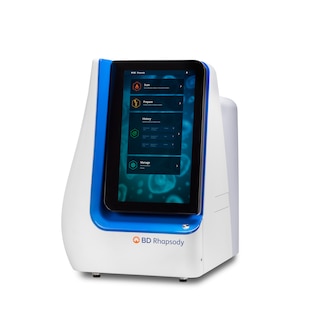-
Your selected country is
Middle East / Africa
- Change country/language
Old Browser
This page has been recently translated and is available in French now.
Looks like you're visiting us from {countryName}.
Would you like to stay on the current country site or be switched to your country?


Oligo Mouse Anti-Mouse CD72 a, b, and d Alloantigens
Regulatory Status Legend
Any use of products other than the permitted use without the express written authorization of Becton, Dickinson and Company is strictly prohibited.
Preparation And Storage
Recommended Assay Procedures
Put all BD® AbSeq Reagents to be pooled into a Latch Rack for 500 µL Tubes (Thermo Fisher Scientific Cat. No. 4900). Arrange the tubes so that they can be easily uncapped and re-capped with an 8-Channel Screw Cap Tube Capper (Thermo Fisher Scientific Cat. No. 4105MAT) and the reagents aliquoted with a multi-channel pipette.
BD® AbSeq tubes should be centrifuged for ≥ 30 seconds at 400 × g to ensure removal of any content in the cap/tube threads prior to the first opening.
Product Notices
- This reagent has been pre-diluted for use at the recommended volume per test. Typical use is 2 µl for 1 × 10^6 cells in a 200-µl staining reaction.
- Source of all serum proteins is from USDA inspected abattoirs located in the United States.
- Caution: Sodium azide yields highly toxic hydrazoic acid under acidic conditions. Dilute azide compounds in running water before discarding to avoid accumulation of potentially explosive deposits in plumbing.
- The production process underwent stringent testing and validation to assure that it generates a high-quality conjugate with consistent performance and specific binding activity. However, verification testing has not been performed on all conjugate lots.
- Illumina is a trademark of Illumina, Inc.
- Please refer to http://regdocs.bd.com to access safety data sheets (SDS).
- Please refer to bd.com/genomics-resources for technical protocols.
- For U.S. patents that may apply, see bd.com/patents.
Companion Products






The K10.6 monoclonal antibody specifically recognizes Lyb-2.1, Lyb-2.2, and Lyb-2.4 (CD72 a, b, and d alloantigens, respectively). CD72 is a 45-kDa type-II membrane protein, containing a C-type lectin-like domain and ITIM and ITIM-like sequences in the cytoplasmic tail. CD72 is expressed at all stages of B-lymphocyte development except plasma cells, and it has been shown to negatively regulate B-cell receptor signaling. Analysis of CD72-deficient mice supports these results and shows that CD72 is involved in B-cell development. CD72-stimulated B cells show a transient association of CD19 with CD72, as well as an increase in Tyr-phosphorylation of CD19. CD72 is reported to be a ligand for CD5, although this is controversial. It is also reported to be a ligand for CD100 (Sema4D). The CD72 alloantigens Lyb-2.1 (originally identified as Ly-m19.2), Lyb-2.2 (originally identified as Ly-32.2), Lyb-2.3, and Lyb-2.4 are encoded by the Cd72[a], Cd72[b], Cd72[c], and Cd72[d] alleles, respectively. Lyb-2.1 is expressed on B lymphocytes of CBA/J, C3H/Bi, C57BR, C57L, C58, DBA/1, DBA/2, and SWR strains. Lyb-2.2 is expressed on B lymphocytes, a subset of peripheral T cells, and activated T lymphocytes in A, BALB/c, CBA/H, C3H/He, C57BL, PL, and 129 strains. Lyb-2.4 is expressed on a subset of splenocytes of the STS/A strain. K10.6 antibody does not react with Lyb-2.3 (AKR and SJL strains) nor with non-lymphoid tissues. Five serological specificities of CD72 alloantigens have been described and the nomenclature CD72.1, CD72.2, CD72.3, CD72.4, and CD72.5 proposed, which does not correspond to the names of the alleles. Some authors have referred to the specificity of mAb K10.6 as CD72.4.
Development References (12)
-
Adachi T, Wakabayashi C, Nakayama T, Yakura H, Tsubata T. CD72 negatively regulates signaling through the antigen receptor of B cells.. J Immunol. 2000; 164(3):1223-9. (Biology). View Reference
-
Bikah G, Lynd FM, Aruffo AA, Ledbetter JA, Bondada S. A role for CD5 in cognate interactions between T cells and B cells, and identification of a novel ligand for CD5. Int Immunol. 1998; 10(8):1185-1196. (Biology). View Reference
-
Doolittle, D.P., M.T. Davisson, J.N. Guidi, and M.C. Green. M.F. Lyon, S. Rastan and S.D.M. Brown, ed. Genetic variants and strains of the laboratory mouse. Oxford : Oxford University Press; 1996:133.
-
Kumanogoh A, Watanabe C, Lee I, et al. Identification of CD72 as a lymphocyte receptor for the class IV semaphorin CD100: a novel mechanism for regulating B cell signaling. Immunity. 2000; 13(5):621-631. (Biology). View Reference
-
Luo W, Van de Velde H, von Hoegen I, Parnes JR, Thielemans K. Ly-1 (CD5), a membrane glycoprotein of mouse T lymphocytes and a subset of B cells, is a natural ligand of the B cell surface protein Lyb-2 (CD72). J Immunol. 1992; 148(6):1630-1634. (Biology). View Reference
-
Pan C, Baumgarth N, Parnes JR. CD72-deficient mice reveal nonredundant roles of CD72 in B cell development and activation. Immunity. 1999 October; 11(4):495-506. (Biology). View Reference
-
Robinson WH, Landolfi MM, Parnes JR. Allele-specific expression of the mouse B-cell surface protein CD72 on T cells. Immunogenetics. 1997; 75(3):195-200. (Biology). View Reference
-
Robinson WH, Landolfi MM, Schäfer H, Parnes JR. Biochemical identity of the mouse Ly-19.2 and Ly-32.2 alloantigens with the B cell differentiation antigen Lyb-2/CD72. J Immunol. 1993 November; 151(9):4764-4772. (Biology). View Reference
-
Robinson WH, Ying H, Miceli MC, Parnes JR. Extensive polymorphism in the extracellular domain of the mouse B cell differentiation antigen Lyb-2/CD72.. J Immunol. 1992; 149(3):880-6. (Biology). View Reference
-
Tada N, Kimura S, Liu Y, Taylor BA, Hämmerling U. Ly-m19: the Lyb-2 region of mouse chromosome 4 controls a new surface alloantigen. Immunogenetics. 1981; 13(6):539-546. (Immunogen). View Reference
-
Venkataraman C, Lu PJ, Buhl AM, Chen CS, Cambier JC, Bondada S. CD72-mediated B cell activation involves recruitment of CD19 and activation of phosphatidylinositol 3-kinase. Eur J Immunol. 1998 October; 28(10):3003-3016. (Biology). View Reference
-
Ying H, Healy JI, Goodnow CC, Parnes JR. Regulation of mouse CD72 gene expression during B lymphocyte development. J Immunol. 1998; 161(9):4760-4767. (Biology). View Reference
Please refer to Support Documents for Quality Certificates
Global - Refer to manufacturer's instructions for use and related User Manuals and Technical data sheets before using this products as described
Comparisons, where applicable, are made against older BD Technology, manual methods or are general performance claims. Comparisons are not made against non-BD technologies, unless otherwise noted.
For Research Use Only. Not for use in diagnostic or therapeutic procedures.
Report a Site Issue
This form is intended to help us improve our website experience. For other support, please visit our Contact Us page.